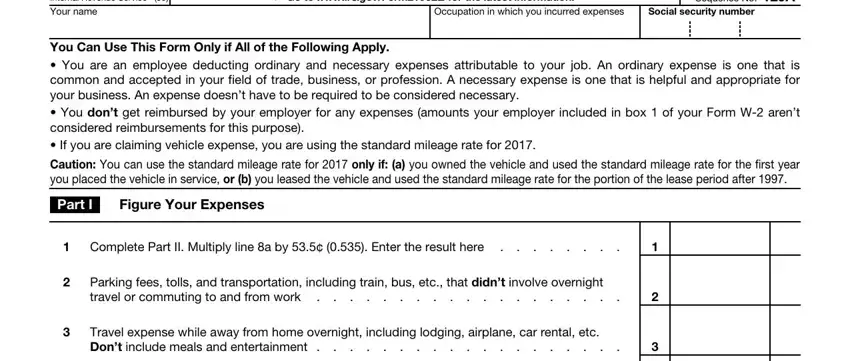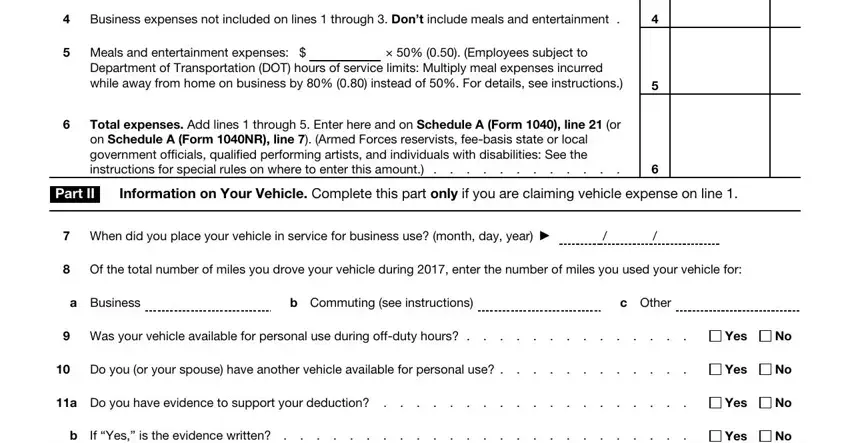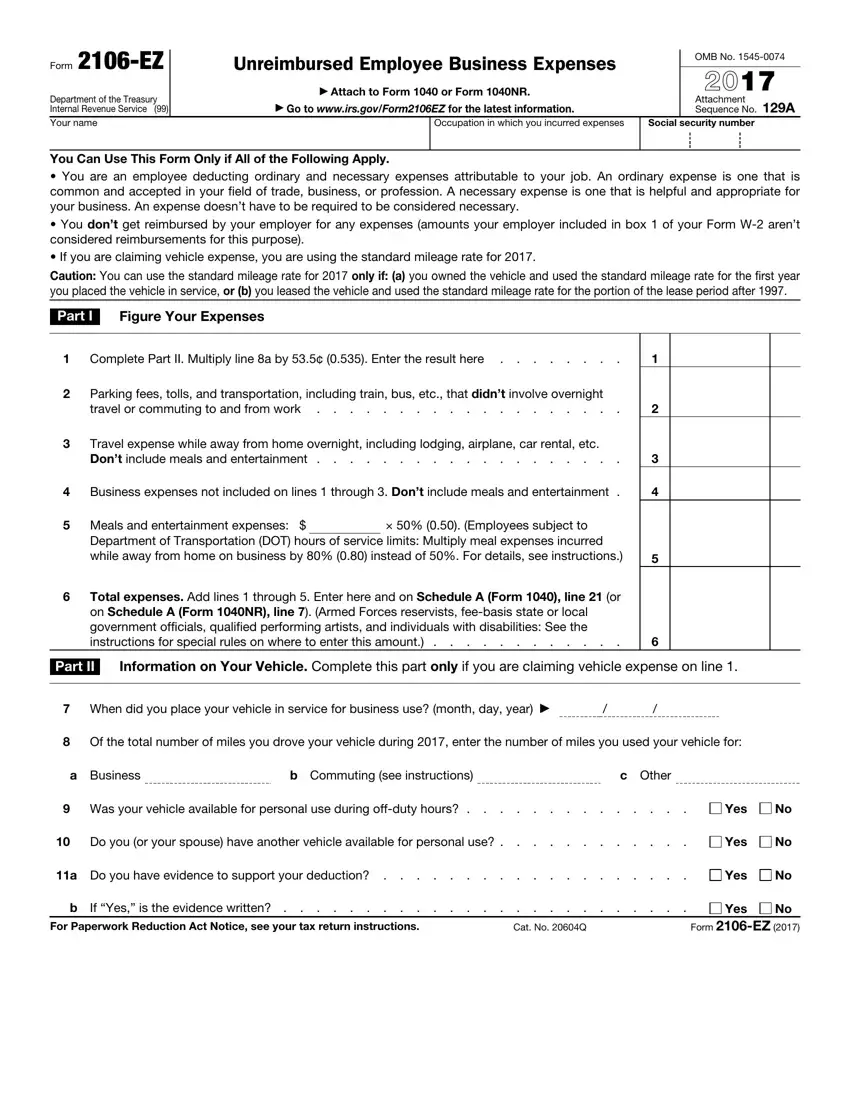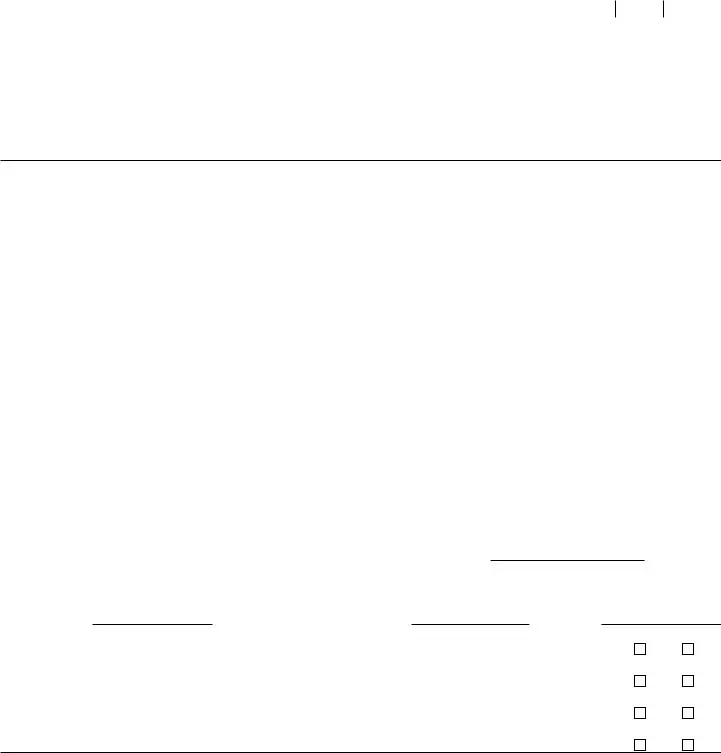Instructions for
Form 2106-EZ
Section references are to the Internal Revenue Code.
Future Developments
For the latest information about developments related to Form 2106-EZ and its instructions, such as legislation enacted after they were published, go to www.irs.gov/Form2106EZ.
What’s New
Standard mileage rate. The 2017 rate for business use of your vehicle is 53.5 cents (0.535) a mile.
Purpose of Form
You can use Form 2106-EZ instead of Form 2106 to claim your unreimbursed employee business expenses if you meet all the requirements listed above Part I of the form.
Recordkeeping
You can’t deduct expenses for travel (including meals, unless you used the standard meal allowance), entertainment, gifts, or use of a car or other listed property, unless you keep records to prove the time, place, business purpose, business relationship (for entertainment and gifts), and amounts of these expenses. Generally, you must also have receipts for all lodging expenses (regardless of the amount) and any other expense of $75 or more.
Additional Information
For more details about employee business expenses, see the following.
•Pub. 463, Travel, Entertainment, Gift, and Car Expenses.
•Pub. 529, Miscellaneous Deductions.
•Pub. 587, Business Use of Your Home.
•Pub. 946, How To Depreciate Property.
Specific Instructions
Part I—Figure Your
Expenses
Line 2. See the line 8b instructions for the definition of commuting.
Line 3. Enter lodging and transportation expenses connected with overnight travel away from your tax home (defined on this page). You generally can’t deduct expenses for travel away from your tax home for any period of temporary employment of more than 1 year. Don’t include expenses for meals and entertainment on this line. For more details, including limits, see Pub. 463.
If you didn’t pay or incur meal expenses on a day you were traveling away from your tax home, you can use an optional method for deducting incidental expenses instead of keeping records of your actual incidental expenses. The amount of the deduction is $5 a day. The term “incidental expenses”
means fees and tips given to porters, baggage carriers, hotel staff, and staff on ships. It doesn’t include expenses for laundry, cleaning and pressing of clothing, lodging taxes, costs of telegrams or telephone calls, transportation between places of lodging or business and places where meals are taken, or the mailing cost of filing travel vouchers and paying employer-sponsored charge card billings. You can’t use this method on any day that you use the standard meal allowance (as explained in the instructions for line 5).
Tax home. Generally, your tax home is your regular or main place of business or post of duty regardless of where you maintain your family home. If you don’t have a regular or main place of business because of the nature of your work, then your tax home may be the place where you regularly live. If you don’t fit in either of these categories, you are considered an itinerant and your tax home is wherever you work. As an itinerant, you are never away from home and can’t claim a travel expense deduction. For more information about determining your tax home, see Pub. 463.
Line 4. Enter other job-related expenses not listed on any other line of this form. Include expenses for business gifts, education (tuition, fees, and books), home office, trade publications, etc. For details, including limits, see Pub. 463 and Pub. 529.
If you are deducting home office expenses, see Pub. 587 for special instructions on how to report these expenses.
If you are deducting depreciation or claiming a section 179 deduction, see Form 4562, Depreciation and Amortization, to figure the depreciation and section 179 deduction to enter on line 4.
Don’t include on line 4 any educator expenses you deducted on Form 1040, line 23, or Form 1040NR.
|
▲ |
At the time these instructions |
|
! |
|
went to print, the tuition and |
|
fees deduction formerly claimed |
|
CAUTION |
on line 34 had expired. To find |
|
|
out if legislation extended the |
deduction so you can claim it on your 2017 return, go to www.irs.gov/Extenders.
You may be able to take a credit for your educational
TIP expenses instead of a deduction. See Form 8863, Education Credits, for details.
Don’t include expenses for meals and entertainment, taxes, or interest on line 4. Deductible taxes are entered on Schedule A (Form 1040), lines 5 through 9; or Schedule A (Form 1040NR), line 1. Employees can’t deduct car loan interest.
Note: If line 4 is your only entry, don’t complete Form 2106-EZ unless you are claiming:
•Expenses for performing your job as a fee-basis state or local government official,
•Performing-arts-related business expenses as a qualified performing artist, or
•Impairment-related work expenses as an individual with a disability.
See the line 6 instructions below for definitions. If you aren’t required to file Form 2106-EZ, enter your expenses directly on Schedule A (Form 1040), line 21 (or on Schedule A (Form 1040NR), line 7).
Line 5. Generally, you can deduct only 50% of your business meal and entertainment expenses, including meals incurred while away from home on business. If you were an employee subject to the DOT hours of service limits, that percentage is 80% for business meals consumed during, or incident to, any period of duty for which those limits are in effect.
Employees subject to the DOT hours of service limits include certain air transportation employees, such as pilots, crew, dispatchers, mechanics, and control tower operators; interstate truck operators and interstate bus drivers; certain railroad employees, such as engineers, conductors, train crews, dispatchers, and control operations personnel; and certain merchant mariners.
Instead of actual cost, you may be able to claim the standard meal allowance for your daily meals and incidental expenses (M&IE) while away from your tax home overnight. Under this method, instead of keeping records of your actual meal expenses, you deduct a specified amount, depending on where you travel. However, you must still keep records to prove the time, place, and business purpose of your travel.
The standard meal allowance is the federal M&IE rate. For most small localities in the United States, this rate is $51 a day. Most major cities and many other localities in the United States qualify for higher rates. You can find these rates at www.gsa.gov/ perdiem.
For locations outside the continental United States, the applicable rates are published each month. You can find these rates at www.state.gov/travel/ and select “Travel Per Diem Allowances for Foreign Areas,” under “Foreign Per Diem Rates.”
See Pub. 463 for details on how to figure your deduction using the standard meal allowance, including special rules for partial days of travel and for transportation workers.
Line 6. If you are one of the individuals discussed below, special rules apply to deducting your employee business expenses.
Ministers. Before entering your total expenses on line 6, you must reduce them by the amount allocable to your tax-free allowance(s). See Pub. 517 for more information.
Armed Forces reservist (member of a reserve component). You are a member of a reserve component of the Armed Forces of the United States if you are in the Army, Navy, Marine Corps, Air Force, or Coast Guard Reserve; the Army National Guard of the United States; the Air National Guard of the United States; or the Reserve Corps of the Public Health Service.





